Actinopterygii (ray-finned fishes) >
Perciformes (Perch-likes) >
Ammodytidae (Sand lances)
Etymology: Ammodytes: Greek, ammos = sand + Greek, dytes = anyone that likes immersions, diving (Ref. 45335). More on author: DeKay.
Environment / Climate / Range
Ecology
Marine; brackish; demersal; depth range 0 - 73 m (Ref. 57178). Temperate, preferred ?; 62°N - 35°N, 82°W - 3°W (Ref. 57356)
Northwest Atlantic: southern Delaware north to Labrador.
Size / Weight / Age
Maturity: Lm ? range ? - ? cm
Max length : 23.5 cm TL male/unsexed; (Ref. 5951)
Short description
Morphology | Morphometrics
Found in shallow coastal waters as well as in protected bays and estuaries (Ref. 10198). Occurs in large schools and burrows in the sand at times to a depth of several inches. Feeds primarily on copepods (Ref. 27549).
Life cycle and mating behavior
Maturity | Reproduction | Spawning | Eggs | Fecundity | Larvae
Nizinski, M.S., B.B. Collette and B.B. Washington, 1990. Separation of two species of sand lances, Ammodytes americanus and A. dubius, in the western North Atlantic. Fish. Bull. 88:241-255. (Ref. 10198)
IUCN Red List Status (Ref. 115185)
CITES (Ref. 94142)
Not Evaluated
Threat to humans
Harmless
Human uses
Fisheries: of potential interest
Tools
Special reports
Download XML
Internet sources
Estimates of some properties based on models
Phylogenetic diversity index (Ref.
82805): PD
50 = 0.5156 [Uniqueness, from 0.5 = low to 2.0 = high].
Bayesian length-weight: a=0.00214 (0.00133 - 0.00345), b=3.14 (3.00 - 3.28), in cm Total Length, based on LWR estimates for this species & Genus-body shape (Ref.
93245).
Trophic Level (Ref.
69278): 3.2 ±0.0 se; Based on diet studies.
Resilience (Ref.
69278): Medium, minimum population doubling time 1.4 - 4.4 years (Preliminary K or Fecundity.).
Vulnerability (Ref.
59153): Moderate vulnerability (37 of 100) .
